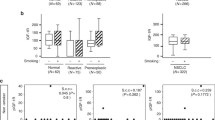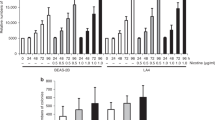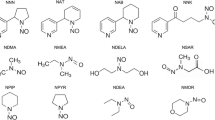Abstract
Identification of the mechanisms leading to malignant transformation of respiratory cells may prove useful in the prevention and treatment of tobacco-related lung cancer. Nitrosamines 4-(methylnitrosamino)-1-(3-pyridyl)-1-butanone (NNK) and N′-nitrosonornicotine (NNN) can induce tumors both locally and systemically. In addition to the genotoxic effect, they have been shown to affect lung cells due to ligating the nicotinic acetylcholine receptors (nAChRs) expressed on the plasma membrane. In this study, we sought to establish the role for nAChRs in malignant transformation caused by NNK and NNN. We used the BEP2D cells that represent a suitable model for studying the various stages of human bronchial carcinogenesis. We found that these cells express α1, α3, α5, α7, α9, α10, β1, β2, and β4 nAChR subunits that can form high-affinity binding sites for NNK and NNN. Exposure of BEP2D cells to either NNK or NNN in both cases increased their proliferative potential which could be abolished in the presence of nAChR antagonists α-bungarotoxin, which worked most effectively against NNK, or mecamylamine, which was most efficient against NNN. The BEP2D cells stimulated with the nitrosamines showed multifold increases of the transcription of the PCNA and Bcl-2 genes by both real-time polymerase chain reaction and in-cell western assays. To gain a mechanistic insight into NNK- and NNN-initiated signaling, we investigated the expression of genes encoding the signal transduction effectors GATA-3, nuclear factor-κB, and STAT-1. Experimental results indicated that stimulation of nAChRs with NNK led to activation of all three signal transduction effectors under consideration, whereas NNN predominantly activated GATA-3 and STAT-1. The GATA-3 protein-binding activity induced by NNK and NNN correlated with elevated gene expression. The obtained results support the novel concept of receptor-mediated action of NNK and NNN placing cellular nAChRs in the center of the pathophysiologic loop, and suggest that an nAChR antagonist may serve as a chemopreventive agent.




Similar content being viewed by others
Abbreviations
- ACh:
-
Acetylcholine
- BEC:
-
Bronchial epithelial cells
- αBtx:
-
α-Bungarotoxin
- GAPDH:
-
Glyceraldehyde-3-phosphate dehydrogenase
- Mec:
-
Mecamylamine
- nAChRs:
-
Nicotinic acetylcholine receptors
- NNK:
-
4-(Methylnitrosamino)-1-(3-pyridyl)-1-butanone
- NNN:
-
N′-Nitrosonornicotine
- RT-PCR:
-
Reverse-transcription polymerase chain reaction
- SAEC:
-
Small airway epithelial cells
- TBD:
-
Trypan blue dye
References
Abravaya K, Myers MP, Murphy SP, Morimoto RI (1992) The human heat shock protein hsp70 interacts with HSF, the transcription factor that regulates heat shock gene expression. Genes Dev 6:1153–1164
Arredondo J, Nguyen VT, Chernyavsky AI, Jolkovsky DL, Pinkerton KE, Grando SA (2001) A receptor-mediated mechanism of nicotine toxicity in oral keratinocytes. Lab Invest 81:1653–1668
Arredondo J, Nguyen VT, Chernyavsky AI, Bercovich D, Orr-Urtreger A, Kummer W, Lips K, Vetter DE, Grando SA (2002) Central role of α7 nicotinic receptor in differentiation of the stratified squamous epithelium. J Cell Biol 159:325–336
Arredondo J, Hall LH, Ndoye A, Nguyen VT, Chernyavsky AI, Bercovich D, Orr-Urtreger A, Beaudet AL, Grando SA (2003) Central role of fibroblast α3 nicotinic acetylcholine receptor in mediating cutaneous effects of nicotine. Lab Invest 83:207–225
Arredondo J, Chernyavsky AI, Marubio LM, Beaudet AL, Jolkovsky DL, Pinkerton KE, Grando SA (2005a) Receptor-mediated tobacco toxicity: regulation of gene expression through α3β2 nicotinic receptor in oral epithelial cells. Am J Pathol 166:597–613
Arredondo J, Chernyavsky AI, Webber RJ, Grando SA (2005b) Biological effects of SLURP-1 on human keratinocytes. J Invest Dermatol 125:1236–1241
Arredondo J, Chernyavsky AI, Pinkerton KE, Jolkovsky DL, Grando SA (2006) Receptor-mediated tobacco toxicity: cooperation of the Ras/Raf-1/MEK1/ERK and JAK-2/STAT-3 pathways downstream of α7 nicotinic receptor in oral keratinocytes. FASEB J (in press)
Beeson D, Morris A, Vincent A, Newsom-Davis J (1990) The human muscle nicotinic acetylcholine receptor alpha-subunit exist as two isoforms: a novel exon. EMBO J 9:2101–2106
Brown DD (1984) The role of stable complexes that repress and activate eukaryotic genes. Philos Trans R Soc Lond B Biol Sci 307:297–299
Carlisle DL, Hopkins TM, Gaither-Davis A, Silhanek MJ, Luketich JD, Christie NA, Siegfried JM (2004) Nicotine signals through muscle-type and neuronal nicotinic acetylcholine receptors in both human bronchial epithelial cells and airway fibroblasts. Respir Res 5:27
Cattaneo MG, D’Atri F, Vicentini LM (1997) Mechanisms of mitogen-activated protein kinase activation by nicotine in small-cell lung carcinoma cells. Biochem J 328(Pt 2):499–503
Cauley K, Marks M, Gahring LC, Rogers SW (1996) Nicotinic receptor subunits α3, α4, and β2 and high affinity nicotine binding sites are expressed by P19 embryonal cells. J Neurobiol 30:303–314
Chen GQ, Lin B, Dawson MI, Zhang XK (2002) Nicotine modulates the effects of retinoids on growth inhibition and RAR beta expression in lung cancer cells. Int J Cancer 99:171–178
Chen BC, Yu CC, Lei HC, Chang MS, Hsu MJ, Huang CL, Chen MC, Sheu JR, Chen TF, Chen TL, Inoue H, Lin CH (2004) Bradykinin B2 receptor mediates NF-kappaB activation and cyclooxygenase-2 expression via the Ras/Raf-1/ERK pathway in human airway epithelial cells. J Immunol 173:5219–5228
Chernyavsky AI, Arredondo J, Karlsson E, Wessler I, Grando SA (2005) The Ras/Raf-1/MEK1/ERK signaling pathway coupled to integrin expression mediates cholinergic regulation of keratinocyte directional migration. J Biol Chem 280:39220–39228
Conti-Tronconi BM, McLane KE, Raftery MA, Grando SA, Protti MP (1994) The nicotinic acetylcholine receptor: structure and autoimmune pathology. Crit Rev Biochem Mol Biol 29:69–123
Cunningham JM, Lennon VA, Lambert EH, Scheithauer B (1985) Acetylcholine receptors in small cell carcinomas. J Neurochem 45:159–167
Dunckley T, Lukas RJ (2003) Nicotine modulates the expression of a diverse set of genes in the neuronal SH-SY5Y cell line. J Biol Chem 278:15633–15640
Elgoyhen AB, Vetter DE, Katz E, Rothlin CV, Heinemann SF, Boulter J (2001) α10: a determinant of nicotinic cholinergic receptor function in mammalian vestibular and cochlear mechanosensory hair cells. Proc Natl Acad Sci USA 98:3501–3506
Fujita T, Maruyama M, Araya J, Sassa K, Kawagishi Y, Hayashi R, Matsui S, Kashii T, Yamashita N, Sugiyama E, Kobayashi M (2002) Hydrogen peroxide induces upregulation of Fas in human airway epithelial cells via the activation of PARP-p53 pathway. Am J Respir Cell Mol Biol 27:542–552
Garrido R, Mattson MP, Hennig B, Toborek M (2001) Nicotine protects against arachidonic-acid-induced caspase activation, cytochrome c release and apoptosis of cultured spinal cord neurons. J Neurochem 76:1395–1403
Gerzanich V, Peng X, Wang F, Wells G, Anand R, Fletcher S, Lindstrom J (1995) Comparative pharmacology of epibatidine: a potent agonist for neuronal nicotinic acetylcholine receptors. Mol Pharmacol 48:774–782
Grando SA (2003) Mucocutaneous cholinergic system is targeted in mustard-induced vesication. Life Sci 72:2135–2144
Grando SA, Horton RM, Pereira EFR, Diethelm-Okita BM, George PM, Albuquerque EX, Conti-Fine BM (1995) A nicotinic acetylcholine receptor regulating cell adhesion and motility is expressed in human keratinocytes. J Invest Dermatol 105:774–781
Grando SA, Schofield OMV, Skubitz APN, Kist DA, Zelickson BD, Zachary CB (1996) Nodular basal cell carcinoma in vivo vs in vitro: establishment of pure cell cultures, cytomorphologic characteristics, ultrastructure, immunophenotype, biosynthetic activities, and generation of antisera. Arch Dermatol 132:1185–1193
Hecht SS (1998) Biochemistry, biology, and carcinogenicity of tobacco-specific N-nitrosamines. Chem Res Toxicol 11:559–603
Hecht SS, Hoffmann D (1988) Tobacco-specific nitrosamines, an important group of carcinogens in tobacco and tobacco smoke. Carcinogenesis 9:875–884
Hecht SS, Carmella SG, Foiles PG, Murphy SE, Peterson LA (1993) Tobacco-specific nitrosamine adducts: studies in laboratory animals and humans. Environ Health Perspect 99:57–63
Izzotti A, Cartiglia C, Longobardi M, Balansky RM, D’Agostini F, Lubet RA, De Flora S (2004) Alterations of gene expression in skin and lung of mice exposed to light and cigarette smoke. FASEB J 18:1559–1561
Jin Z, Gao F, Flagg T, Deng X (2004) Tobacco-specific nitrosamine 4-(methylnitrosamino)-1-(3-pyridyl)-1-butanone promotes functional cooperation of Bcl2 and c-Myc through phosphorylation in regulating cell survival and proliferation. J Biol Chem 279:40209–40219
Jull BA, Plummer HK 3rd, Schuller HM (2001) Nicotinic receptor-mediated activation by the tobacco-specific nitrosamine NNK of a Raf-1/MAP kinase pathway, resulting in phosphorylation of c-myc in human small cell lung carcinoma cells and pulmonary neuroendocrine cells. J Cancer Res Clin Oncol 127:707–717
Koga Y, Satoh S, Sodeyama N, Hashimoto Y, Yanagisawa T, Hirshman CA (1992) Role of acetylcholinesterase in airway epithelium-mediated inhibition of acetylcholine-induced contraction of guinea-pig isolated trachea. Eur J Pharmacol 220:141–146
Kurzen H, Berger H, Jager C, Hartschuh W, Naher H, Gratchev A, Goerdt S, Deichmann M (2004) Phenotypical and molecular profiling of the extraneuronal cholinergic system of the skin. J Invest Dermatol 123:937–949
Lindstrom J, Peng AR, Gerzanich V (1995) Neuronal nicotinic receptor structure and function. In: Clarke PBS, Quik M, Adlkofer F, Thurau K (eds) Effects of nicotine on biological systems. Birkhäuser, Basel, pp 45–50
Mai H, May WS, Gao F, Jin Z, Deng X (2003) A functional role for nicotine in Bcl2 phosphorylation and suppression of apoptosis. J Biol Chem 278:1886–1891
Majno G, Joris I (1995) Apoptosis, oncosis, and necrosis: an overview of cell death. Am J Pathol 146:3–15
Maneckjee R, Minna JD (1990) Opioid and nicotine receptors affect growth regulation of human lung cancer cell lines. Proc Natl Acad Sci USA 87:3294–3298
Maneckjee R, Minna JD (1994) Opioids induce while nicotine suppresses apoptosis in human lung cancer cells. Cell Growth Diff 5:1033–1040
Maus ADJ, Pereira EFR, Karachunski PI, Horton RM, Navaneetham D, Macklin K, Cortes WS, Albuquerque EX, Conti-Fine BM (1998) Human and rodent bronchial epithelial cells express functional nicotinic acetylcholine receptors. Mol Pharmacol 54:779–788
Minna JD (2003) Nicotine exposure and bronchial epithelial cell nicotinic acetylcholine receptor expression in the pathogenesis of lung cancer. J Clin Invest 111:31–33
Murrah VA, Gilchrist EP, Moyer MP (1993) Morphologic and growth effects of tobacco-associated chemical carcinogens and smokeless tobacco extracts on human oral epithelial cells in culture. Oral Surg Oral Med Oral Pathol 75:323–332
Nguyen VT, Hall LL, Gallacher G, Ndoye A, Jolkovsky DL, Webber RJ, Buchli R, Grando SA (2000a) Choline acetyltransferase, acetylcholinesterase, and nicotinic acetylcholine receptors of human gingival and esophageal epithelia. J Dent Res 79:939–949
Nguyen VT, Ndoye A, Grando SA (2000b) Novel human α9 acetylcholine receptor regulating keratinocyte adhesion is targeted by pemphigus vulgaris autoimmunity. Am J Pathol 157:1377–1391
Niphadkar MP, Contractor QQ, Bhisey RA (1994) Mutagenic activity of gastric fluid from chewers of tobacco with lime. Carcinogenesis 15:927–931
Ohrui T, Sekizawa K, Yamauchi K, Ohkawara Y, Nakazawa H, Aikawa T, Sasaki H, Takishima T (1991) Chemical oxidant potentiates electrically and acetylcholine-induced contraction in rat trachea: possible involvement of cholinesterase inhibition. J Pharmacol Exp Ther 259:371–376
Proskocil BJ, Sekhon HS, Jia Y, Savchenko V, Blakely RD, Lindstrom J, Spindel ER (2004) Acetylcholine is an autocrine or paracrine hormone synthesized and secreted by airway bronchial epithelial cells. Endocrinology 145:2498–2506
Ptashne M (1988) How eukaryotic transcriptional activators work. Nature 335:683–689
Quik M, Chan J, Patrick J (1994) α-Bungarotoxin blocks the nicotinic receptor mediated increase in cell number in a neuroendocrine cell line. Brain Res 655:161–167
Racke K, Matthiesen S (2004) The airway cholinergic system: physiology and pharmacology. Pulm Pharmacol Ther 17:181–198
Schuller HM, Orloff M (1998) Tobacco-specific carcinogenic nitrosamines. Ligands for nicotinic acetylcholine receptors in human lung cancer cells. Biochem Pharmacol 55:1377–1384
Schuller HM, Nylen E, Park P, Becker KL (1990) Nicotine, acetylcholine and bombesin are trophic growth factors in neuroendocrine cell lines derived from experimental hamster lung tumors. Life Sci 47:571–578
Schuller HM, Jull BA, Sheppard BJ, Plummer HK (2000) Interaction of tobacco-specific toxicants with the neuronal α7 nicotinic acetylcholine receptor and its associated mitogenic signal transduction pathway: potential role in lung carcinogenesis and pediatric lung disorders. Eur J Pharmacol 393:265–277
Schuller HM, Plummer HK 3rd, Jull BA (2003) Receptor-mediated effects of nicotine and its nitrosated derivative NNK on pulmonary neuroendocrine cells. Anat Rec 270A:51–58
Sgard F, Charpantier E, Bertrand S, Walker N, Caput D, Graham D, Bertrand D, Besnard F (2002) A novel human nicotinic receptor subunit, α10, that confers functionality to the α9-subunit. Mol Pharmacol 61:150–159
Shriver SP, Bourdeau HA, Gubish CT, Tirpak DL, Davis AL, Luketich JD, Siegfried JM (2000) Sex-specific expression of gastrin-releasing peptide receptor: relationship to smoking history and risk of lung cancer. J Natl Cancer Inst 92:24–33
Sistonen L, Sarge KD, Morimoto RI (1994) Human heat shock factors 1 and 2 are differentially activated and can synergistically induce hsp70 gene transcription. Mol Cell Biol 14:2087–2099
Sonenberg N, Hershey JWB, Mathews MB (2000) Translational control of gene expression, 2nd edn. Cold Spring Harbor Laboratory, New York
Song P, Sekhon HS, Jia Y, Keller JA, Blusztajn JK, Mark GP, Spindel ER (2003a) Acetylcholine is synthesized by and acts as an autocrine growth factor for small cell lung carcinoma. Cancer Res 63:214–221
Song P, Sekhon HS, Proskocil B, Blusztajn JK, Mark GP, Spindel ER (2003b) Synthesis of acetylcholine by lung cancer. Life Sci 72:2159–2168
Steinbach JH (1990) Mechanism of action of the nicotinic acetylcholine receptor. In: Bock G, Marsh J (eds) The biology of nicotine dependence. Meeting, London, England, UK, 7–9 November 1989. Wiley, New York, pp 53–61
Sun X, Liu Y, Hu G, Wang H (2004) Protective effects of nicotine against glutamate-induced neurotoxicity in PC12 cells. Cell Mol Biol Lett 9:409–422
Taisne C, Norel X, Walch L, Labat C, Verriest C, Mazmanian GM, Brink C (1997) Cholinesterase activity in pig airways and epithelial cells. Fundam Clin Pharmacol 11:201–205
Tarroni P, Rubboli F, Chini B, Zwart R, Oortgiesen M, Sher E, Clementi F (1992) Neuronal-type nicotinic receptors in human neuroblastoma and small-cell lung carcinoma cell lines. FEBS Lett 312:66–70
Trump BF, Berezesky IK, Chang SH, Phelps PC (1997) The pathways of cell death: oncosis, apoptosis, and necrosis. Toxicol Pathol 25:82–88
Wang Y, Pereira EF, Maus AD, Ostlie NS, Navaneetham D, Lei S, Albuquerque EX, Conti-Fine BM (2001) Human bronchial epithelial and endothelial cells express alpha7 nicotinic acetylcholine receptors. Mol Pharmacol 60:1201–1209
West KA, Brognard J, Clark AS, Linnoila IR, Yang X, Swain SM, Harris C, Belinsky S, Dennis PA (2003) Rapid Akt activation by nicotine and a tobacco carcinogen modulates the phenotype of normal human airway epithelial cells. J Clin Invest 111:81–90
Willey JC, Broussoud A, Sleemi A, Bennett WP, Cerutti P, Harris CC (1991) Immortalization of normal human bronchial epithelial cells by human papillomaviruses 16 or 18. Cancer Res 51:5370–5377
Williams CL (2003) Muscarinic signaling in carcinoma cells. Life Sci 72:2173–2182
Williams CL, Lennon VA (1991) Activation of muscarinic acetylcholine receptors inhibits cell cycle progression of small cell lung carcinoma. Cell Regul 2:373–382
Wogan GN, Hecht SS, Felton JS, Conney AH, Loeb LA (2004) Environmental and chemical carcinogenesis. Semin Cancer Biol 14:473–486
Zhao L, Kuo YP, George AA, Peng JH, Purandare MS, Schroeder KM, Lukas RJ, Wu J (2003) Functional properties of homomeric, human alpha 7-nicotinic acetylcholine receptors heterologously expressed in the SH-EP1 human epithelial cell line. J Pharmacol Exp Ther 305:1132–1141
Zhou H, Calaf GM, Hei TK (2003) Malignant transformation of human bronchial epithelial cells with the tobacco-specific nitrosamine, 4-(methylnitrosamino)-1-(3-pyridyl)-1-butanone. Int J Cancer 106:821–826
Zia S, Ndoye A, Nguyen VT, Grando SA (1997) Nicotine enhances expression of the α3, α4, α5, and α7 nicotinic receptors modulating calcium metabolism and regulating adhesion and motility of respiratory epithelial cells. Res Commun Mol Pathol Pharmacol 97:243–262
Acknowledgments
This work was supported by the NIH grants CA117327 and DE14173, and a research grant from Flight Attendant Medical Research Institute to S.A.G.
Author information
Authors and Affiliations
Corresponding author
Additional information
Juan Arredondo and Alex I. Chernyavsky contributed to this paper equally. Their names are listed in alphabetical order.
Rights and permissions
About this article
Cite this article
Arredondo, J., Chernyavsky, A.I. & Grando, S.A. The nicotinic receptor antagonists abolish pathobiologic effects of tobacco-derived nitrosamines on BEP2D cells. J Cancer Res Clin Oncol 132, 653–663 (2006). https://doi.org/10.1007/s00432-006-0113-9
Received:
Accepted:
Published:
Issue Date:
DOI: https://doi.org/10.1007/s00432-006-0113-9




